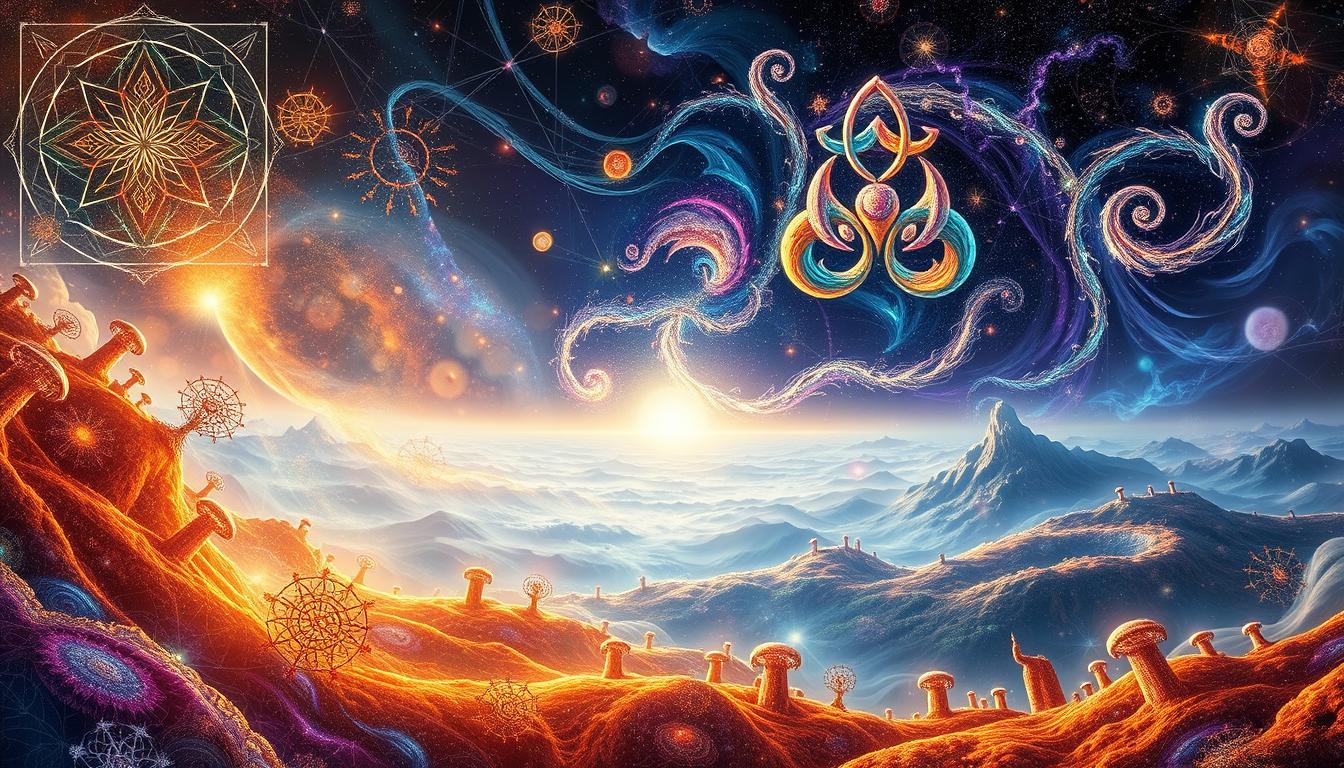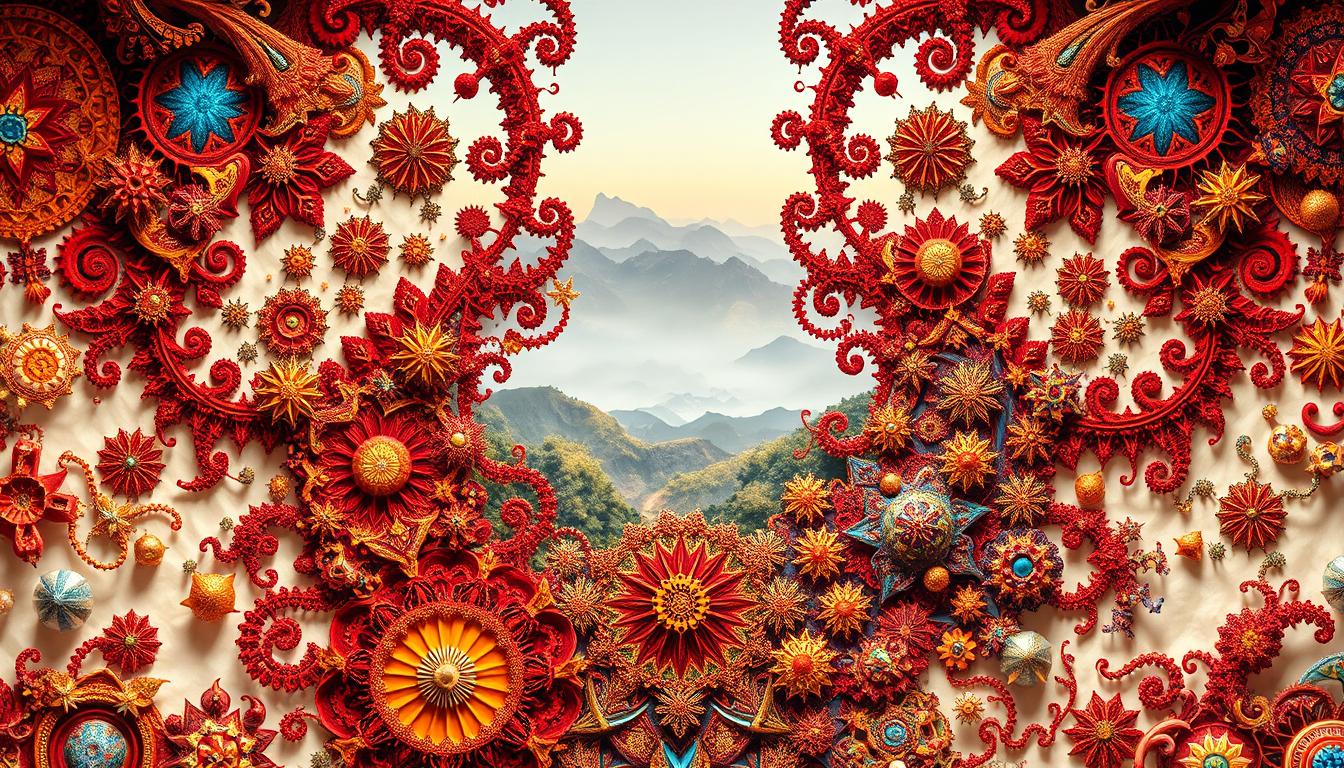Fractal cosmologies combine math with the universe’s order. They show us how complex patterns form and connect. This field shows us nature’s patterns tell us about the cosmos. Each shape helps us understand the universe better.
By studying these patterns, we learn about the universe’s balance. This encourages us to think and ask questions about our place in the universe.
The Concept of Fractals in Nature
Fractals are where math meets nature. They have repeating patterns and are similar across different scales. Their complexity comes from simple math, like the Mandelbrot set. This example shows how simple equations create endless patterns. It highlights math’s role in understanding nature.
Defining Fractals and Their Mathematical Foundations
Fractals blend simple rules with complex results. They reflect overall shapes in their smaller parts. By using recursion, they create detailed results from basic rules. The Mandelbrot set, a primary example, turns a basic equation into varied, detailed patterns. This helps us get how nature’s shapes form mathematically.
Examples of Fractals in Natural Systems
Nature is filled with fractals that dazzle us. Examples include:
- The way trees branch out, each limb copying the full tree.
- Snowflakes, with their unique but orderly shapes.
- River networks, branching for efficient water movement.
- Leaf patterns that catch the most sunlight for plants.
These show fractals’ role in nature, offering both beauty and function. They teach us about the complex, beautiful systems in our world. By noticing these fractals, we gain appreciation for nature’s detailed design.

Understanding Universal Order
The cosmos follows a fascinating order that both captures our interest and tests our knowledge. When we explore how the universe is ordered, we discover a mix of structure and chaos. This mix helps us understand how everything in the universe works together, showing the role of entropy and thermodynamics.
The Principles Governing Order in the Cosmos
Universal order comes from key physical laws and self-organization. According to the second law of thermodynamics, closed systems move toward more entropy, leading to more disorder. Yet, we see organized systems, like galaxies and life, forming from simpler parts. This shows a balance between order and chaos, proving that order can exist even as things tend to become more disordered.
Contrasts with Entropy and Disorder
Entropy suggests things naturally move toward messiness, but the story of life evolves differently. Earth’s history shows life becoming more complex and orderly over time. This interesting difference makes us look closer at how energy moves in systems not in equilibrium. We learn that self-organization is key in creating structures that show the universe’s order.
Fractal Cosmologies: Where Nature’s Patterns Meet Universal Order
Studying fractal geometries offers deep insights into the cosmos. There’s a complex link between these geometries and cosmic structures. This connection shows patterns that rule the vast universe and small details of life on Earth.
Interconnection between Fractal Geometries and Cosmological Structures
Fractal geometries appear in cosmic formations, like galaxies. These show repeated patterns on different scales. Such patterns reflect how energy and matter are similar in nature. This means the rules for tiny life forms are like those for huge cosmic events in the universe.
Self-Similarity in Cosmic Structures
Self-similarity marks cosmic structures seen in galaxies and star clusters. They form a cosmic web showing the universe’s fractal nature. The order in small systems also appears on a universal scale. This hints at a profound connection across all existence levels.
Self-Organization in Nonequilibrium Systems
Nonequilibrium thermodynamics studies systems outside of thermodynamic balance. It explores how energy flow can trigger spontaneous order, forming complex structures from simple beginnings. This challenges the usual ideas about entropy, showing ways order can spring from chaos.
Unpacking the Concept of Nonequilibrium Thermodynamics
This field shows how certain conditions lead to the formation of organized structures. Energy gradients act as a push, driving systems to change and become more complex. It helps us see how systems respond to outside forces, creating patterns and structures on their own.
Real-World Examples: Chemical Reactions and Biological Systems
There are many examples of self-organization in action. For instance, the Belousov-Zhabotinsky reaction. This reaction creates fascinating patterns from simple chemicals. Another example is Benard instability in heated fluids, where convection cells form defined structures. These examples highlight self-organization’s role in various systems, in both nature and labs.
The Role of Quantum Mechanics in Fractal Cosmologies
Quantum mechanics plays a key role in understanding fractal cosmologies. It shows us how everything in the universe is connected. This field of physics talks about things like quantum entanglement. This means particles are closely linked, even over long distances. These particles reflect the repeating patterns seen in fractals, revealing the complexities of our existence.
Fractal cosmologies have patterns that show consistency across different sizes. Quantum mechanics deepens our insight into these patterns. It highlights how everything is connected beyond our usual understanding of space. This connection reflects the natural order we see around us in different forms.
Studying quantum behaviors helps us get a better understanding of fractal shapes and the universe. Quantum mechanics explains the balance between order and chaos. It shows how everything is interconnected in the universe. By combining these ideas, we learn how quantum mechanics and fractal cosmologies give us a clearer view of reality.
Revolutionary Insights: Bridging Science and Consciousness
Recently, science and philosophy started talking more. They’re combining old wisdom with new quantum theories. This mix helps us understand consciousness better. It shows us it’s a part of the universe’s intelligence.
Integrating Ancient Wisdom with Modern Quantum Theories
Vedic ideas match up with quantum science. Both believe everything in the universe is connected. Old wisdom says consciousness goes beyond just us. It aligns with quantum theories that say reality is full of connections and chances. This makes us rethink our place in the cosmos. It shows how old thoughts can make new science richer.
The Implications for Human Consciousness and Identity
Looking at consciousness with quantum ideas shows us more about who we are. It makes us think about our place in the big universe. We start to wonder how our awareness fits into the universe’s fabric. This view makes us see ourselves as more than just physical beings. It helps us understand our true potential in the cosmos.
Fractal Patterns in the Cosmic Web
The cosmic web is a complex and beautiful structure in the universe. It consists of galaxies, dark matter, and the space between, all showing fractal patterns. Experts have found that these patterns repeat at different sizes. This tells us the universe has a well-organized structure shaped by math.
Exploring the Structure of the Universe
With powerful telescopes, scientists have studied the cosmic web in detail. They found it is made up of fractal patterns. This tells us how galaxies and dark matter spread out over huge areas. The similar patterns in big and small scales show the universe’s organized and intricate design.
Parallels Between Cosmic and Neuronal Networks
Recent research shows similarities between the cosmic web and our brain’s networks. Both have fractal patterns, pointing to a common organizing principle. The way galaxies connect looks like neural pathways in the brain. This comparison suggests universal mathematical rules govern both the universe and our minds.
Impacts of Fractal Cosmologies on Modern Science
Studying fractal cosmologies has deeply affected modern science. It touches many areas of research. Scientists exploring fractal patterns learn new things about the universe and complex systems.
Shaping Research Across Multiple Disciplines
Fractal concepts spark new ideas in many sciences. Researchers in fields like physics and biology use fractal theories. This leads to new discoveries.
- Enhanced modeling of physical phenomena, leading to refined predictions.
- Improved understanding of biological patterns, such as growth and adaptation.
- Innovative analytical methods that unify various scientific approaches.
Case Studies and Emerging Theories in Physics and Biology
Exciting case studies show how powerful fractal cosmology can be. It offers ideas that connect physics and biology. Examples include:
- How patterns of self-organization in biological systems can reflect fractal principles.
- Linkages between cosmic structures and quantum frameworks, suggesting a unified perspective.
- Insights into dynamic systems that challenge traditional models, pushing boundaries in both disciplines.
The Future of Fractal Cosmologies in Understanding Reality
Exploring the future of fractal cosmologies shows how science and philosophy mix. Researchers see the promise in fractal geometries for grasping reality’s complexities. As theories grow, they could link different systems, living and non-living.
This mixed approach encourages teamwork between scientists, artists, and thinkers. By taking in varied views, new methods may emerge. These methods will enrich talks on life and our cosmic role. The future of fractal cosmologies aims to deepen our understanding of reality. It also hopes to build a view that includes different human experiences.
Conclusion
The study of fractal cosmologies shows how math and nature are closely linked. By looking at nature’s complex patterns, we learn about the world’s balance. These insights show us the beauty in how everything is connected.
This field connects science with deeper spiritual meanings, helping us grasp the true nature of our world. It makes reality clearer to us.
Fractal cosmologies teach us about human consciousness and who we are. They show us a bigger picture of our place in the universe. This encourages us to explore the depths of our existence.
By understanding fractal cosmologies, we gain valuable insights into life’s complex puzzle. It helps us see the connections among all living things. Through this understanding, we can appreciate the harmony that rules the universe and our part in it.



